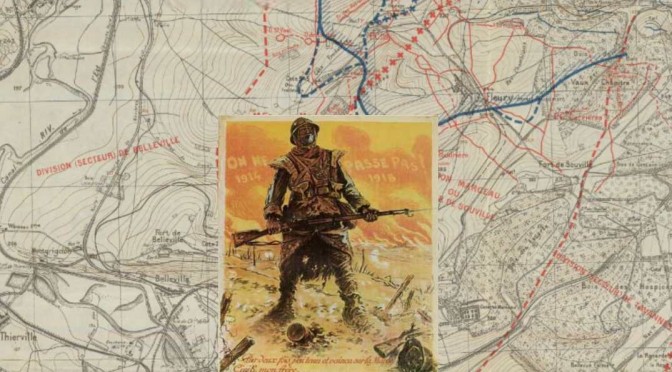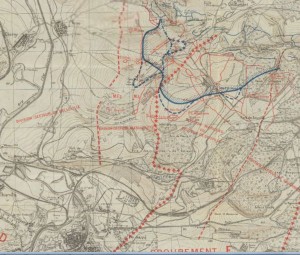“On ne passe pas’” (They shall not pass!) emerged from the battle of Verdun as watchwords of French. This phrase, widely attributed to General Phillip Petain has been used as a rallying cry for France since then, and an inspiration for subsequent defiance by, among others, Spanish Republicans, south American revolutionaries and the Russian Feminist group Pussy Riot. But like many national symbols and iconic events, much of the story is myth, factoid rather than fact. But the story behind the myth does reveal something about the battle of Verdun and the men who coined the catch phrase.
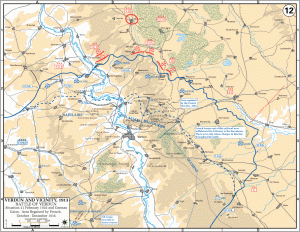 Verdun was one of the major battles of the First World War, costing the French and the Germans about a quarter of a million casualties each. The battles of Verdun and the Somme, linked inextricably, dominated the Western Front in 1916. The Germans intended to break the French Army by forcing it to fight a battle of attrition under unfavourable circumstances. The battle was launched with heavy artillery support on 22nd February 1916. Catching the French ill prepared, the offensive was initially successful, inflicting heavy casualties on the French and their forces in disarray, crowned by the capture of Fort Douamont on the 25th February.
Verdun was one of the major battles of the First World War, costing the French and the Germans about a quarter of a million casualties each. The battles of Verdun and the Somme, linked inextricably, dominated the Western Front in 1916. The Germans intended to break the French Army by forcing it to fight a battle of attrition under unfavourable circumstances. The battle was launched with heavy artillery support on 22nd February 1916. Catching the French ill prepared, the offensive was initially successful, inflicting heavy casualties on the French and their forces in disarray, crowned by the capture of Fort Douamont on the 25th February.

The same day, General Petain, commander of the Second Army, was ordered to take charge of the Verdun sector. He was chosen purely because his army was in reserve and available. Petain was an infantryman with an undistinguished pre war career only enlivened by his rejection of the pre war orthodoxy that willpower and aggression could overcome modern weapons. As an instructor at the Ecole de Guerre he preached the heresy that “firepower kills,” with the logical implication that a well organised defence would stop the Attaque à outrance (attack to excess). His rise to army command in the first eighteen months of the war had confirmed the need to “separate the real from the imaginary and the possible from impossible.”i An address to a decimated regiment illustrates this.
You went into the assault singing the Marseillaise; It was magnificent. But next time you will not need to sing the Marseillaise. There will be a sufficient number of guns to ensure your attack’s success.
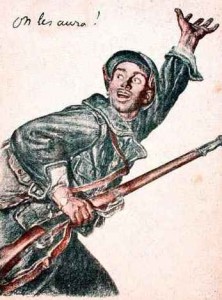
The measures Petain took to defend Verdun were based on firepower and belief that there were no short cuts to victory. He centralised control of the artillery and massed defensive fires where it could be most effective. He organised administration and logistics and arranged for a systematic and early replacement of formations committed to Verdun, known as the “Noria” (bucket chain) or “tourniquet” (turnstile).
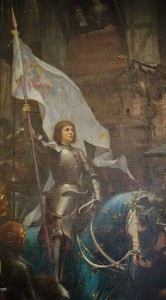
On 10th April Petain issued an order of the day which ended with the phrase “Courage, on les auras” (Take heart, we’ll get them.) This was meant to stick in the memory as a catch phrase. It was a allusion to the words of Joan of Arc at Orleans. “Nos ennemis, fussent-ils pendu aux nuages, nous les aurons! Et nous les bouterons hors de France!” (Our enemies, even if they hung in the clouds, we shall get them! And we will drive them out of France!) They were a reminder of the need for patience a war that could only be won by only fighting winnable battles but might take a long time.
Petain’s realistic, pessimistic approach to value counter attacks, did him no favours with Joffre, the French commander in chief or with the politicians. On 27th April Petain was promoted to Commander of the Central Region, and replaced as commander of the 2nd Army, by General Robert Nivelle who was more to Joffre’s taste.
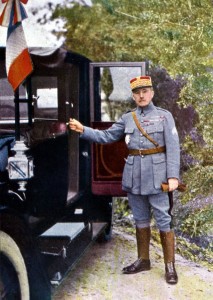 Like Petain a mere colonel in 1914, Nivelle’s career had a meteoric trajectory. A heroic action at the Marne was followed by successful command of a brigade, divisional and corps. A whole hearted believed of the ideas of de Gradnmaison, Nivelle believed that success in battle was based on the will to win and that flawed leadership (but not his) led to “defaillance”, (weakness or breakdown). However, artilleryman Nivelle was also aware of the necessity of good infantry artillery co-operation. He was probably responsible for the most important technical development that enabled attacks to succeed, the barrage roulant – the creeping barrage.
Like Petain a mere colonel in 1914, Nivelle’s career had a meteoric trajectory. A heroic action at the Marne was followed by successful command of a brigade, divisional and corps. A whole hearted believed of the ideas of de Gradnmaison, Nivelle believed that success in battle was based on the will to win and that flawed leadership (but not his) led to “defaillance”, (weakness or breakdown). However, artilleryman Nivelle was also aware of the necessity of good infantry artillery co-operation. He was probably responsible for the most important technical development that enabled attacks to succeed, the barrage roulant – the creeping barrage.
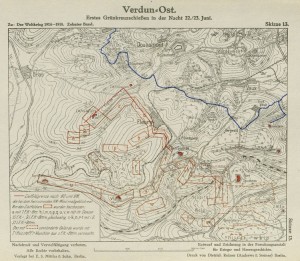
On 23 June 1916 the Germans planned a major attack by their elite mountain corps. This would be preceded by “Green Cross”, chemical artillery shells containing Phosgene, a new very lethal choking agent, which the Germans thought might penetrate French gas masks.
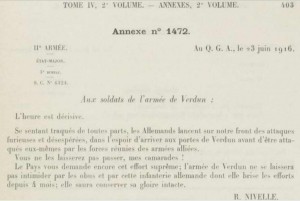
The phosgene barrage caused consternation and 1,800 casualties, mainly among French gunners. By the end of the day German infantry penetrated the furthest they ever achieved towards Verdun. Nivelle issued an order of the day that included the words “Vous ne les laisserez passer, mon camadares” (“You will do not let them pass”
Crisis at the battle of Verdun 23 June 1916. The solid blue line shows the French line before the attack. The dashed line shows the furthest extent of the German advance and the blue crosses the positions restored by the French by 2nd July
This wasn’t an original phrase. It had been circulating among the troops for some time, but there is no evidence that Petain used the phrase himself It was an appeal drawing on ‘cran’ (guts) very much Nivelle’s style . However this was out of character for Petain whose command style was based on promises of artillery support and avoided appeals for flesh to face material or attempt the physically impossible.
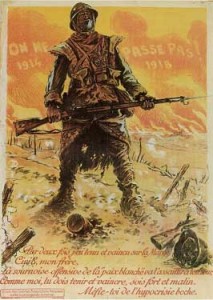 The crisis passed and the very next day, the preliminary barrage started on the battle of the Somme. From this moment Verdun became a secondary sector. However, throughout the remainder of 1916 Nivelle, occasionally constrained by Petain conducted a series of counter attacks which cumulated in the dramatic recapture of the Fort Douemont on 24th October. On that day the French troops advancing under a creeping barrage recaptured the ground that it had taken the Germans months to capture.
The crisis passed and the very next day, the preliminary barrage started on the battle of the Somme. From this moment Verdun became a secondary sector. However, throughout the remainder of 1916 Nivelle, occasionally constrained by Petain conducted a series of counter attacks which cumulated in the dramatic recapture of the Fort Douemont on 24th October. On that day the French troops advancing under a creeping barrage recaptured the ground that it had taken the Germans months to capture.
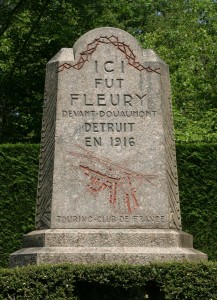
At the end of 1916, the French government had lost confidence in Joffre, their commander in chief, held responsible for the neglect of the defences of Verdun and the disappointing results of the Somme offensive. On the 27th December 1916 Joffre was promoted to Marshall and removed from command, to be replaces by Nivelle, who promised a decisive victory if allowed to use his tactics on larger scale. The failure of the Nivelle Offensive in May 1917 and the subsequent mutinies led to Nivelle’s fall and replacement by Petain. Nivelle was largely forgotten and Verdun became, in the public mind synonymous with Petain.

In the meantime he catch phrase “On ne passe pas” , to use an anachronism, went viral. It joined “Old Contemptables” “In Flanders Fields” and “over the top” evoking aspects of the war. The call for the spirit to over come material odds made it attractive for the underdog and even chic.
The difference catch phrases of Petain and Nivelle illustrate different approaches to the battle of Verdun. They were also present in the British high command. The logic of Petain’s approach leads to the “bite and hold “ school identified with Rawlinson and Plumer, while Nivelle’s appeal to strength of will has much in common with the “Harroshing” of Haig and Gough. Indeed, Haig’s “Backs to the wall” order of the day in April 1918 is very similar to Nivelle’s appeal on 23 June.
If you ever need to use this article to settle a bet, donations are always welcomed by the battlefields Trust, a UK Charity dedicated to preservation, interpretation and presentation of battlefield heritage. Battlefields Trust Just Giving
There is a lot to see at Verdun, where far more of the battlefield was abandoned after the war. Far fewer Britons visit Verdun, know as much about this battle or even its connection to the battle of the Somme. If you are interested in visiting the battlefield of Verdun or other battlefields of the Western Front contact me.
